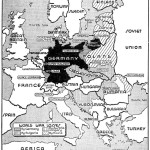Please find the map that we were using to explain the Locarno Treaties below. The key point to remember is that Germany would guarantee her western borders and pledged never to invade Belgium and France again (along with a guarantee from Britain  that they would come to Germany’s aid if it was attacked by France). This was Stresemann’s fulfilment policy – erfullugspolitik in action. It was followed by;
that they would come to Germany’s aid if it was attacked by France). This was Stresemann’s fulfilment policy – erfullugspolitik in action. It was followed by;
- 1926: Germany joined the League of Nations and signed the Treaty of Berlin with USSR (the agreements made at Rapallo in 1922).
- 1928: Germany signed the Kellogg-Briand Pact, thereby renouncing the use of force and committing herself to disarmament
- 1929: The Young Plan – a revised scheme for repaying Reparations. The allies agree to evacuate the Rhineland early.
Today we debate Stresemann’s motives, and the wisdom of Locarno. It was certainly hated in Moscow. However, Low’s reaction in the cartoon at the top of the page was typical at the time, and added to the idea of growing stability in Europe. David Low is perhaps the greatest political cartoonist to have worked in Twentieth Century Britain. If you want to know more about him and the genre then click here to read my earlier post.
Mr Kydd




